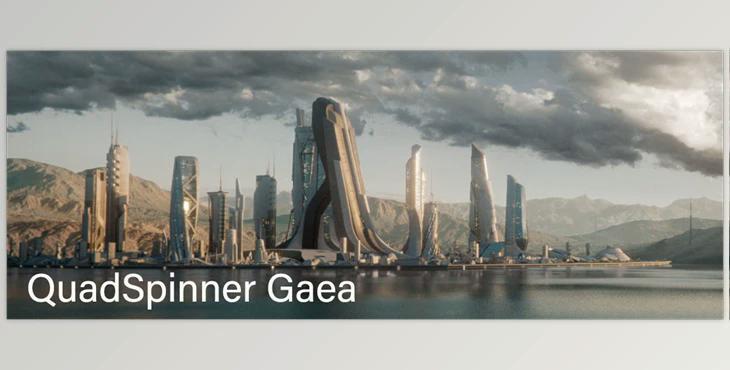
Quadspinner Gaea 1.3.2.7 (WIN) X64:
"Gaea I have found that "Gaea is the latest next-generation tool that is way ahead times its age.
QuadSpinner are artists who are passionate themselves, who fully comprehend the demands of artists working in the environment."
THE COMPLETE TERRAIN SOLUTION
Gaea incorporates geological forms advanced erosion snow, river, and erosion models, and rock tools along with one of the most complete texture generators into easy user-friendly nodes that can be utilized by anyone within 10 minutes of education.
Concept to Production
Working with CG is often a struggle for programmers and artists. Gaea helps to end that conflict. It allows you to achieve your goals with the right tooling from beginning to end. For those rare occasions that you aren't able to find anything out of the box, Gaea's procedural toolkit allows you to easily make your own.
Realistic Terrains
Creating the terrain in CG is very simple. It's a lot easier to create a realistic terrain... it's difficult unless you've got the proper tools.
Gaea's toolkit is focused on real-world principles and not CG models. You are working with canyons, mountains, as well as craters. Not noises or filters. Gaea organizes these ideas into nodes and presents their properties in simple-to-understand configurations.
(Btw We still have filters, noises, and all the other low-level equipment you'd ever need to drill into the simplest elements.)
Tools for each step in your process
Create. Erode. Simulate. Modify. Colorize. The 150+ color nodes will guide you through every step of the process.
There are many alternatives for every aspect of the process. For some specific jobs, you'll have a wide range of options. For instance, our most efficient simulator of node Erosion can also be found in a lightweight version known as Wizard. It can perform all the common erosion tasks with no learning curve.
Non-destructive graph workflow
CG supervisors art directors, supervisors, and TDs have been an advocate for Gaea. The non-destructive workflow, augmented through baking and mutation provides quick turnarounds and small changes while retaining an artistically-designed look.
TRANSPOSE SHAPES
Gaea's Embed operation is able to transfer details across terrains. It is possible to create details such as cracked rocks, cracks, and various other components on flat surfaces. You can then lay them over non-uniform terrains in an after-process.
The Insert counterpart function can be used to take a few elements like rocks or huge solitary shapes and then insert them into another heightfield while keeping the shape and integrity of both.
Procedural... everything!
Gaea was created from scratch to fill a problem in the industry: a procedural terrain workflow that is based on analogs from nature rather than the shader-like method of the previous generation. This new workflow is exhibited via geo-centric nodes, processing, and simulations that are wrapped with artist-friendly layers.
Gaea's procedural nature and the use of both low and high-level nodes means that you will always be able to create innovative solutions on your own.
Explore terrains that are beyond
We know that the landscape that you design in Gaea will form the basis of a larger universe. To give the most realistic results, Gaea enables you to collect data from terrain and perform simulations of other natural phenomena in order to generate important data.
The data could be used within Gaea to enable further processing of your terrain. It also could be exported as point clouds, masks, and meshes in order to create your engine games and DCC applications.
NATURAL SIMULATIONS
Alongside the various kinds that are a result of Erosion, Gaea produces realistic Snow, River, Ice as well as different natural phenomena. You can control these simulations by using masks and other data.
You can, for instance, utilize the composite sun map for a certain interval of time in order to trigger melting snow.
Aspect-oriented Texturing
Terrains that are textured in Gaea always appear more detailed and real.
The procedural processes employed to build the terrain produce procedural data on various elements of the terrain. In the case of terrains that do not have these kinds of data or where the data was reprocessed (e.g. creating an effect on erosion, which makes the erosion flow obsolete) Gaea's Data Maps can recreate the data. They can even work with satellite data!
Create textures at the source
The intricate aspects of terrain are obtained using Data Maps. They are generated by mask generators like Texture, Arboreal, and Vegetation and are able for creating textures that wouldn't be possible in any external paint program or any other procedural texture software.
COMPLEX COLORIZATION
Gaea's 1,000+ Satellite Color Maps are able to rapidly colorize the terrain using real-world colors that are captured from all over the world. It is possible to use the Texture node to create an intricate texture mask that allows this color map.
Smart Terrain Exports
It is possible to save your landscapes in high-resolution heightfields by using standard 2 sizes, like 4096 x 4096 or 8192 x 8192. In the case of Unreal or Unity, you'll have the option to export your terrain at resolutions that match the engine you're using.
Gaea can export terrains in meshes, either using extremely optimized decimation or lossless grids.
OPTIMIZED MESHES + LODS
Gaea's Sophia algorithm generates highly optimized meshes that allocate the right amount of polygons exactly where they are needed. In contrast to traditional decimation optimization, the optimal meshes maintain the same topology. They can reduce the number of polygons by as much as 60%, based on the nature of your terrain.
You can export grid-based and optimized meshes to the terrain, and switch between them when needed. Gaea can generate accurate LODs of the meshes.